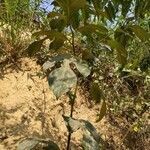Trees to 40 m tall, deciduous. Bark black, gray, or brown, coarse. Branchlets furrowed when dry, 4-8 mm thick, pubescence rust-colored to reddish yellow, hairs long and spreading to bent. Stipules amplexicaul. Leaves spirally arranged; petiole brown, 1.5-4.5 cm, densely pubescent; leaf blade elliptic, oblong, or ovate, 13-37 × 6-21 cm, abaxially densely rust-colored to grayish white pubescent but more densely so along veins, adaxially glabrous or with sparse bent hairs, base broadly cuneate to rounded, margin entire or ± crenate, apex acute to shortly acuminate; secondary veins 9-18 on each side of midvein, apically curved, and joined together near margin, tertiary veins reticulate and with dark brown glandular points. Inflorescences axillary, solitary. Male inflorescences ellipsoid, ovoid, or clavate, 1.2-2.3 × 1-1.8 cm; bracts shield-shaped; pedicel ca. 2 mm, shortly pubescent. Female inflorescences globose to ellipsoid; bracts peltate. Style exserted. Male flowers: calyx lobes 2 or 3, ca. 5 mm, margin ciliate; filaments short; anthers ellipsoid. Fruiting syncarp yellow when young then rust-colored brown, ± globose, 5-6 cm in diam.; peduncle 1.5-4.5 cm, with short brown hairs; persistent calyx separating near top, with several persistent bracts. Drupes ellipsoid, ca. 10 × 6 mm.
More
A tree. It loses its leaves during the year. It grows 40 m tall. The bark is grey to brown. It peels off in flakes. The leafy growths (stipules) at the base of the leaves are oval and 2.5 cm long. These are yellow and hairy. The leaves are oval and 14-23 cm long by 9-14 cm wide. Young leaves are divided. The flowers occur singly in the axils of leaves. The male heads are roundish and 1.5-3 cm by 1-3 cm. The female heads have hairy bracts. The fruit is almost round and 6-10 cm across. The seeds are 7 mm long by 4 mm wide. The fruit are edible.

